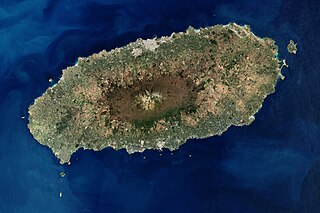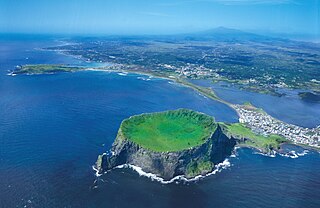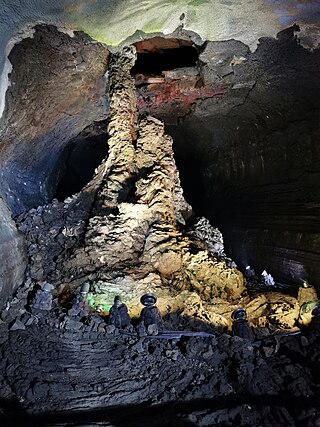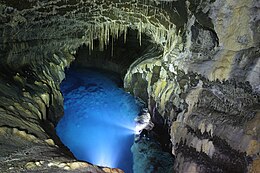
Mount Pelée or Mont Pelée is an active volcano at the northern end of Martinique, an island and French overseas department in the Lesser Antilles Volcanic Arc of the Caribbean. Its volcanic cone is composed of stratified layers of hardened ash and solidified lava. Its most recent eruption was in 1932.

Jeju Province, officially Jeju Special Self-Governing Province, is the southernmost province of South Korea, consisting of 8 inhabited and 55 uninhabited islands, including Mara Island, U Island, the Chuja Archipelago, and the country's largest island Jeju Island. The province is located in the Korea Strait, with the Korean Peninsula to the northwest, Japan to the east, and China to the west. The province has two cities: the capital Jeju City, located on the northern half of the island and Seogwipo, located on the southern half of the island. The island is home to the shield volcano Hallasan, the highest point in South Korea. Jeju and Korean are the official languages of the province, and the vast majority of residents are bilingual.

Hallasan (Korean: 한라산) is a shield volcano on Jeju Island in South Korea. Its summit, at 1,947 m (6,388 ft), is the highest point in the country. The area around the mountain is a designated national park, named Hallasan National Park. Hallasan is commonly considered to be one of the three main mountains of South Korea, along with Jirisan and Seoraksan.

A lava tube, or pyroduct, is a natural conduit formed by flowing lava from a volcanic vent that moves beneath the hardened surface of a lava flow. If lava in the tube empties, it will leave a cave.

The KamchatkaPeninsula is a 1,250-kilometre-long (777 mi) peninsula in the Russian Far East, with an area of about 270,000 km2 (100,000 sq mi). The Pacific Ocean and the Sea of Okhotsk make up the peninsula's eastern and western coastlines, respectively. Immediately offshore along the Pacific coast of the peninsula runs the 10,500-metre-deep (34,449 ft) Kuril–Kamchatka Trench.

Seogwipo is the second-largest city on Jeju Island, settled on a rocky volcanic coastline in the southern part of Jeju Province, South Korea. In July 2006, Seogwipo's boundaries were expanded to include the entire southern half of Jeju island. A UNESCO World Heritage Site and 2002 FIFA World Cup host, it had a population of 155,691 as of December 31, 2011.

A parasitic cone is the cone-shaped accumulation of volcanic material not part of the central vent of a volcano. It forms from eruptions from fractures on the flank of the volcano. These fractures occur because the flank of the volcano is unstable. Eventually, the fractures reach the magma chamber and generate eruptions called flank eruptions, which, in turn, produce a parasitic cone.

Jeju Island is South Korea's largest island, covering an area of 1,833.2 km2 (707.8 sq mi), which is 1.83 percent of the total area of the country. Alongside outlying islands, it is part of Jeju Province.

Korea comprises the Korean Peninsula and 3,960 nearby islands. The peninsula is located in Northeast Asia, between China and Japan. To the northwest, the Amnok River separates Korea from China and to the northeast, the Duman River separates Korea from China and Russia. The Yellow Sea lies to the west, the East China Sea and Korea Strait to the south, and the Korean East Sea to the east. Notable islands include Jeju Island (Jejudo), Ulleung Island (Ulleungdo), and the Liancourt Rocks.

Daepo Jusangjeolli Cliff is a volcanic rock formation at the southern coast of Jeju Island, South Korea. It is named for jusangjeolli, the Korean term for columnar jointing.
Mulyeongari-oreum is a lake and wetland located on Jeju island. It is the only wetland in Korea which is located within a volcanic crater in a parasitic cone, called an oreum in the Jeju dialect of Korean. The oreum is one of the secondary volcanoes around the Hallasan volcano, which is the highest mountain in South Korea. Through continuing scientific research, it is thought that Mulyeongari-oreum was formed by volcanic activity continuing for 2,500 years at the end of the third Cenozoic Era on Jeju Island. On top of the oreum, there is a shallow crater lake which displays a unique example of a wetland. The level of water changes with the seasons due to rainfall and the particular geology. Some 370 parasitic cones are located around Hallasan. Only about 30% of them have mountain craters. The geology is mostly composed of water-permeable basalt, so it is unusual to have a lake on top of such volcanic cones. During the dry season, most of wetland becomes dries out, except the deepest part in the south. During the rainy season, most of it is submerged.

Hallasan National Park is located on and around the mountain Hallasan in Jeju Province, South Korea. It was designated as the 9th national park in 1970.

Seongsan Ilchulbong, also called ‘Sunrise Peak’, is an archetypal tuff cone formed by hydrovolcanic eruptions upon a shallow seabed about 5 thousand years ago. Situated on the eastern seaboard of Jeju Island and said to resemble a gigantic ancient castle, this tuff cone is 182 meters high, has a preserved bowl-like crater and also displays diverse inner structures resulting from the sea cliff. These features are considered to be of geologic worth, providing information on eruptive and depositional processes of hydromagmatic volcanoes worldwide as well as past volcanic activity of Seongsan Ilchulbong itself.

The Geomunoreum Lava Tube System is located between Seonheul-ri, Jocheon-eup and Weoljeong-ri, Gujwa-eup, Jeju City, Jeju-do. This lava tube system refers to a series of lava tubes formed by multiple ancient eruptions of basaltic lava flow from the Geomunoreum volcano The flows followed a north-northeast direction for about 13km, going down to the coastline. It is estimated that the tube system formed between about 100 and 300 thousand years ago.

Manjanggul (Korean: 만장굴) is a lava tube located in Gimnyeong-ri, Gujwaeup, Jeju City, South Korea. At up to 23 metres (75') wide, 30 metres (100') high and 8.928 km long, it is the 12th-longest lava tube in the world and the second longest on Jeju Island, although a significant portion of the cave is closed to visitors. It is the only cave of the Geomunoreum Lava Tube System, considered one of the finest lava tube systems in the world, regularly open to the public. It is also part of the UNESCO World Heritage Site list, under the item Jeju Volcanic Island and Lava Tubes.
The Gimnyeonggul Lava Tube, located in Donggimnyeong-ri, Gujwa-eup, Jeju City, is one of the World Heritage Sites in South Korea.
Mt. Songak (Korean: 송악산) is a volcano on Jeju Island which has double craters and a parasitic cone. Crater 1 is about 500 m in diameter, 1.7 km in circumference. Crater 2, the mouth of the volcano in Crater 1, is about 400 m in diameter, 69 m in depth and leans vertically.
Jeju Oreum is a rising small defunct volcano in the Jeju Island in South Korea. The word "oreum" is the Jeju dialect which implies the parasitic cone [Hangul: 측화산, Hanja: 側火山 and the origin of the word "oreum" is a noun type of the word "climb". The name refers to a small volcano within a main volcanic crater in Jeju-do and is usually applied to the hill in Jeju. The cinder cone, symbolizing the oreum, is a typical form of Jeju Oreum. The Oreum is divided into pyroclastic cone, tuff cone and lava dome depending on the nature of volcanic eruptions. The pyroclastic cones are volcanic bodies formed by the accumulation of volcanic clusters released into the air by an explosive eruption.














